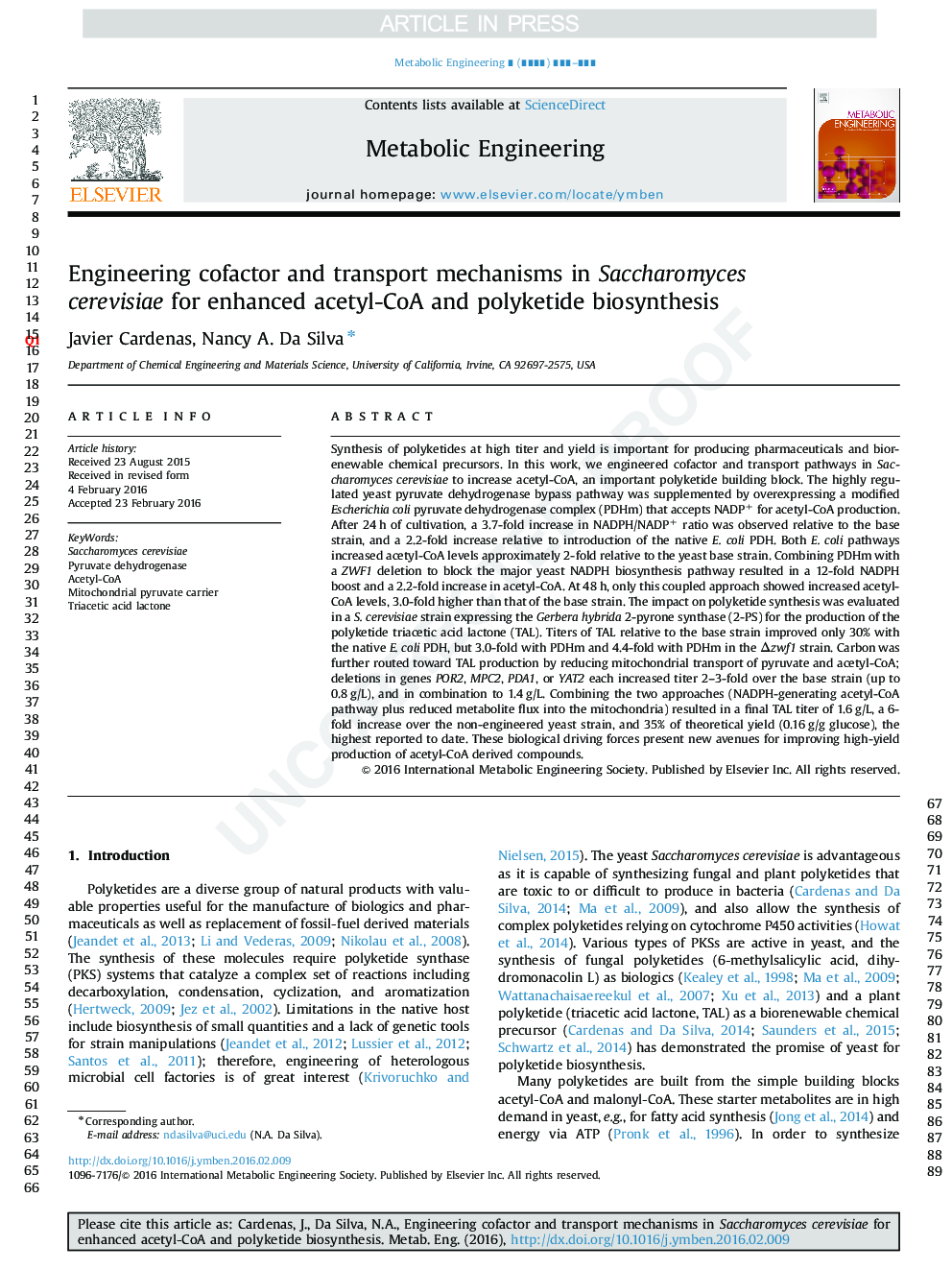| کد مقاله | کد نشریه | سال انتشار | مقاله انگلیسی | نسخه تمام متن |
|---|---|---|---|---|
| 6494262 | 44801 | 2016 | 10 صفحه PDF | دانلود رایگان |
عنوان انگلیسی مقاله ISI
Engineering cofactor and transport mechanisms in Saccharomyces cerevisiae for enhanced acetyl-CoA and polyketide biosynthesis
دانلود مقاله + سفارش ترجمه
دانلود مقاله ISI انگلیسی
رایگان برای ایرانیان
کلمات کلیدی
موضوعات مرتبط
مهندسی و علوم پایه
مهندسی شیمی
بیو مهندسی (مهندسی زیستی)
پیش نمایش صفحه اول مقاله

چکیده انگلیسی
Synthesis of polyketides at high titer and yield is important for producing pharmaceuticals and biorenewable chemical precursors. In this work, we engineered cofactor and transport pathways in Saccharomyces cerevisiae to increase acetyl-CoA, an important polyketide building block. The highly regulated yeast pyruvate dehydrogenase bypass pathway was supplemented by overexpressing a modified Escherichia coli pyruvate dehydrogenase complex (PDHm) that accepts NADP+ for acetyl-CoA production. After 24Â h of cultivation, a 3.7-fold increase in NADPH/NADP+ ratio was observed relative to the base strain, and a 2.2-fold increase relative to introduction of the native E. coli PDH. Both E. coli pathways increased acetyl-CoA levels approximately 2-fold relative to the yeast base strain. Combining PDHm with a ZWF1 deletion to block the major yeast NADPH biosynthesis pathway resulted in a 12-fold NADPH boost and a 2.2-fold increase in acetyl-CoA. At 48Â h, only this coupled approach showed increased acetyl-CoA levels, 3.0-fold higher than that of the base strain. The impact on polyketide synthesis was evaluated in a S. cerevisiae strain expressing the Gerbera hybrida 2-pyrone synthase (2-PS) for the production of the polyketide triacetic acid lactone (TAL). Titers of TAL relative to the base strain improved only 30% with the native E. coli PDH, but 3.0-fold with PDHm and 4.4-fold with PDHm in the Îzwf1 strain. Carbon was further routed toward TAL production by reducing mitochondrial transport of pyruvate and acetyl-CoA; deletions in genes POR2, MPC2, PDA1, or YAT2 each increased titer 2-3-fold over the base strain (up to 0.8Â g/L), and in combination to 1.4Â g/L. Combining the two approaches (NADPH-generating acetyl-CoA pathway plus reduced metabolite flux into the mitochondria) resulted in a final TAL titer of 1.6Â g/L, a 6.4-fold increase over the non-engineered yeast strain, and 35% of theoretical yield (0.16Â g/g glucose), the highest reported to date. These biological driving forces present new avenues for improving high-yield production of acetyl-CoA derived compounds.
ناشر
Database: Elsevier - ScienceDirect (ساینس دایرکت)
Journal: Metabolic Engineering - Volume 36, July 2016, Pages 80-89
Journal: Metabolic Engineering - Volume 36, July 2016, Pages 80-89
نویسندگان
Javier Cardenas, Nancy A. Da Silva,